Dastar
A dastār (Punjabi: ਦਸਤਾਰ, from Persian: دستار) which derives from dast-e-yaar or "the hand of God", is an item of headwear associated with Sikhism and is an important part of the Sikh culture. The word is loaned from Persian through Punjabi. In Persian, dastar can mean any kind of turban (not just the Sikh headwear) and replaced the original word for turban, dolband (دلبند), from which the English word is derived.
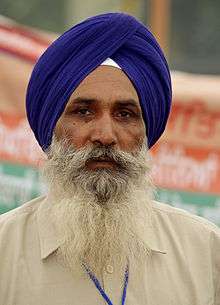
| Part of a series on |
| Sikh practices and discipline |
|---|
Among the Sikhs, the dastaar is an article of faith that represents honour, self-respect, courage, spirituality, and piety. The Khalsa Sikh men and women, who keep the Five Ks, wear the turban to cover their long, uncut hair (kesh). The Sikhs regard the dastaar as an important part of the unique Sikh identity.
Guru Nanak Dev, the founder of Sikhism was born into a Hindu family. However, Nanak did not believe in the Hindu practices of the time and sought to re-teach the original teachings of Hinduism according to the Vedas, which believes in one omnipresent and omnipotent creator Ekongkar and the universal brotherhood of man. He emphasized a philosophy of love for spiritual existence juxtaposed with ordinary living, laying emphasis on 'earning a livelihood by the sweat of your brow'. The ninth Sikh Guru, Tegh Bahadur, was sentenced to death by the Mughal emperor Aurangzeb. Guru Gobind Singh, the tenth Sikh Guru created the Khalsa in order to protect the weak and downtrodden and gave five articles of faith, one of which is unshorn hair and the Dastar helps keep it tidy.
History
The dastaar has been an important part of the Sikh religion since the time of the First Guru. Guru Nanak Dev ji honoured Guru Amar Das with a special dastaar when he was declared the next Guru. When Guru Ram Das died, Guru Arjun Dev was honoured with the dastaar of Guruship.
- Marne di pag Pirthiye badhi. Guriyaee pag Arjan Ladhi[1]
Guru Gobind Singh, the last human Sikh Guru, wrote:
- Kangha dono vaqt kar, paag chune kar bandhai. ("Comb your hair twice a day and tie your turban carefully, turn by turn.")
Bhai Rattan Singh Bhangu, one of the earliest Sikh historians, wrote in Sri Gur Panth Parkash:[2]
- Doi vele utth bandhyo dastare, pahar aatth rakhyo shastar sambhare
- Kesan ki kijo pritpal, nah(i) ustran se katyo vaal
- Tie your Dastaar twice a day and wear shaster (weapons to protect dharma), and keep them with care, 24 hours a day.
- Take good care of your hair. Do not cut your hair by blade.
Significance
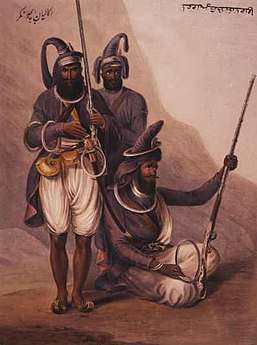
In the Khalsa society, the turban signifies many virtues:
- Spirituality
- The dastaar is a symbol of spirituality, holiness, and humility in Sikhism.
- Honour and self-respect
- The dastaar is also a symbol of honour and self-respect. In the Punjabi culture, those who have selflessly served the community are traditionally honoured with turbans.
- Piety and moral values
- The dastaar also signifies piety and purity of mind. In the Punjabi society, the Khalsa Sikhs are considered as protectors of the weak, even among the non-Sikhs. In the older times, the Khalsa warriors moved from village to village at night, during the battles. When they needed a place to hide from the enemy, the womenfolk, who had a very high degree of trust in them used to let them inside their houses. It was a common saying in Punjab: Aye nihang, booha khol de nishang ("The nihangs are at the door. Dear woman! go ahead open the door without any fear whatsoever.")
- Courage
- Sikhs wear a dastaar, to cover their long hair, which is never cut, as per the command of their previous Guru, Guru Gobind Singh. There are many references in the Sikh history that describe how Guru Gobind Singh personally tied beautiful dumalas (dastaar) on the heads of both his elder sons Ajit Singh and Jujhar Singh, and how he personally gave them arms, decorated them like bridegrooms, and sent them to the battlefield at Chamkaur Sahib where they both died as martyrs. A blue-colored turban is especially identified with courage, sacrifice and martyrdom.
- Friendship and relationship
- Pag Vatauni ("exchange of turban") is a Punjabi custom, in which the men exchange dastaars with their closest friends. Once they exchange turbans they become friends for life and forge a permanent relationship. They take a solemn pledge to share their joys and sorrows under all circumstances. Exchanging turban is a glue that can bind two individuals or families together for generations.
- Sayings
There are many Punjabi idioms and proverbs that describe how important is a dastaar in one's life. Bhai Gurdas writes:[3]
- Tthande khuhu naike pag visar(i) aya sir(i) nangai
- Ghar vich ranna(n) kamlia(n) dhussi liti dekh(i) kudhange
- ("A man, after taking a bath at the well during winter time, forgot his Dastaar at the well and came home bareheaded.
- When the women saw him at home without a Dastaar, they thought someone had died and they started to cry.")
Uniform of Sikhism
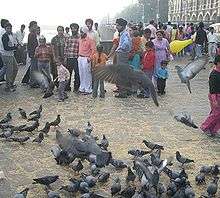
The Dastaar is considered an integral part of the unique Sikh identity. The bare head is not considered appropriate as per gurbani. If a Sikh wants to become one with his/her guru, he/she must look like a guru (wear a dastaar). Guru Gobind Singh stated:
- Khalsa mero roop hai khaas. Khalse me hau karo niwas.
- ("Khalsa is a true picture of mine. I live in Khalsa.")
Maintaining long hair and tying the dastaar is seen as a token of love, obedience of the wishes of Sikh gurus, and acceptance to the Will of God. A quote from Sikhnet:[4]
The Dastaar is our Guru's gift to us. It is how we crown ourselves as the Singhs and Kaurs who sit on the throne of commitment to our own higher consciousness. For men and women alike, this projective identity conveys royalty, grace, and uniqueness. It is a signal to others that we live in the image of Infinity and are dedicated to serving all. The turban doesn't represent anything except complete commitment. When you choose to stand out by tying your Dastaar, you stand fearlessly as one single person standing out from six billion people. It is a most outstanding act.
Styles of dastaars
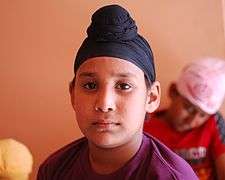

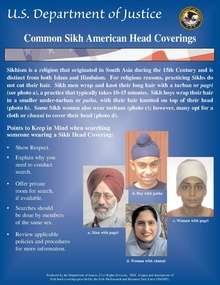
- Men's Double Patti (Nok)
- This is a very common Sikh turban style. It is very common in Punjab, India. The nok is a double wide dastaar. Six meters of the dastaar cloth are cut in half, then into two three meter pieces. They are then sewn together to make it double wide, thus creating a "double patti," or a nok dastarr. This dastaar is larger than most Sikh dastaars, but contains fewer wraps around the head.
- Chand Tora
- This style of turban is generally worn by Nihang Sikh men . This is a warrior style dastaar meant for going into battle. The "Chand Tora" is a metal symbol consisting of a crescent and a double edged sword. It is held in place at the front of the dastaar by woven chainmail cord tied in a pattern within the dastaar to protect the head from slashing weapons.
- Amritsar Dhamala
- This is the most common Dhamala dastaar. It consists of:
- one five meter piece (Pavo Blue)
- one 11 meter piece any color, commonly sabz (white) and pavo blue. Both pieces are 35 cm wide, and referred to in Amritsar as Dhamala Material.
- Basic Dhamala
- This is a very simple and basic Dhamala Sikh dastaar. This is the most popular turban among young Sikhs of the Akhand Kirtani Jatha and also quite popular among those of Damdami Taksal in countries like America, the United Kingdom and Canada.
- General Sikh Dastaar
- Another common Sikh dastaar style for men. Unlike the "double patti" dastaar, the dastaar is longer and goes seven times around the head. If you use the "Notai" technique and have a big joora (hair knot), do not make it right in front at your forehead. You will end up tying the dastaar on the joora, and it will make your dastaar look very high and big. According to modern Punjabi style the last (larh) of dastaar is given a "V" shape by using the Dastaar pin. Sikhs also use a specially designed dastaar needle (Punjabi: Salai,ਸਲਾਈ OR Baaj,ਬਾਜ) to tuck their hair inside from dastaar and patka and also to maintain dastaar cleanliness.
- Keski
- This is a common sikh dastaar among Sikhs. It is normally used as more of a casual turban, or sometimes for sports. Commonly, this is a peela (shade of yellow) coloured turban.
- Patiala Shahi turban
- Nowadays this type of dastar is widely famous in boys. This type of dastar was first tied by Patiala King Bhupinder Singh. From his name the name of this type is originated 'Patiala Shahi'.
- Morni Pagg
- It is a very famous style of turban and is very pointed.
These are the basic Sikh Pugaree types. Turban theory states that the main pugaree types are starting points, and anyone can invent their own Dastaar styles.
- Kenyan or UK style turban
- This is a common sikh Dastaar among young men in the Sikh Diaspora. It originated in Kenya, hence its name, among the Sikhs there. In 1970s many Kenyan Sikhs migrated to the UK, making it popular there. Its design is very smart and elegant. Famous people like Jus Reign, Raj Grewal, singer Jassi Sidhu wear different variations of this style.
In May 2009, The Times of India reported that British researchers were trying to make a "bulletproof turban" that would allow the Sikhs in the British police to serve in firearms units.[5]
Harassment faced by turban-wearing Sikhs
After the September 11, 2001 attacks in USA, a number of dastaar-wearing Sikhs faced assaults by some Americans who confused them with Muslims, who were being associated with terrorism.[6][7]. Due to Sikh Turbans resembling turban that Osama Bin Laden wore in his most iconic photo, United States Department of Justice worked with the Sikh American Legal Defense and Education Fund (SALDEF) to issue a poster aimed at getting Americans acquainted with Sikh turbans.[8]
Conflicts with civil law

In modern times, there have been conflicts between Sikhs – especially those outside India – and laws which conflict with always wearing a dastaar. Sikh soldiers refused to wear helmets during World War I and World War II. Many Sikhs have refused to remove the dastaar even in jails. Sikh scholar and social activist Bhai Randhir Singh underwent a fast to be able to wear a dastaar in prison.
In the UK in 1982, the headmaster of a private school refused to admit an orthodox Sikh as a pupil unless he removed the dastaar and cut his hair. This led to the long legal battle, Mandla v. Dowell Lee, a case which contributed to the creation of the legal term "ethno-religious".[9][10]
In Canada in 1990, the Supreme Court of Canada ruled that Baltej Singh Dhillon, an Royal Canadian Mounted Police officer, should be allowed to wear a dastaar while on duty. See the case of Grant v. Canada A.G (1995) 125 D.L.R. (4th) 556 (F.C.A.) aff'd (1994) 81 F.T.R. 195 (F.C.T.D.) (Reed J.) where the court said that the Sikh RCMP officer had a constitutional right to wear his Dastaar and that the government’s decision to accommodate him was required to protect freedom of religion:
"The defendants and the intervenors, particularly the able argument of Ms. Chotalia for the Alberta Civil Liberties Association, turn the plaintiffs' argument respecting discrimination on its head. They argue that the Commissioner's decision was designed to prevent discrimination occurring to Khalsa Sikhs. As such they argue that that decision offends none of the provisions of the Charter, indeed that it is required by section 15 of the Charter." para 103 Shirish Chotalia, Alberta lawyer, represented the Sikh Society of Calgary, the Alberta Civil Liberties Association, and the Friends of the Sikhs, pro bono.[11]
In the United States in 2002, Jasjit Singh Jaggi, a Sikh traffic policeman employed with the New York Police Department, was forced to leave his job because he insisted on wearing a dastaar on duty. He petitioned with the New York Human Rights Commission, and in 2004 a US judge ruled that he should be reinstated.[12]
In France in 2004, the Sikh community protested against the introduction of a law prohibiting the display of any religious symbols in state-run schools.[13][14] The Shiromani Gurdwara Parbandhak Committee urged the French Government to review the bill, stating that the ban would have grave consequences for the Sikhs.[15] The Government of India discussed the matter with the French officials, who stated that an exception for turbaned Sikh boys in French public schools was not possible.[16]
In 2007, the Canadian government introduced new procedures for accommodation of Sikhs in regard to passport photos, driver licensing, and other legal licensing. This bill was also supported by the Sikh Council of Canada.
In April 2009, Capt. Kamaljit Singh Kalsi and 2nd Lt. Tejdeep Singh Rattan challenged a U.S. Army order that they remove their turbans and shave their beards.[17] In March 2010, Rattan became the first Sikh to graduate Army Officer School at Fort Sam Houston since the exemption was eliminated in 1984; a waiver was granted for his religion. Kalsi will also attend basic training.[18]
In Ireland, Ravinder Singh Oberoi applied to become a member of the voluntary police force Garda Reserve but was not permitted to wear a dastaar. He unsuccessfully claimed discrimination on grounds of race and religion; the High Court ruled in 2013 on a preliminary issue that he could not claim under employment equality legislation as he was not an employee and was not in vocational training.[19]
Instances of acceptance
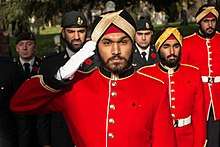
In 2012 British media reported that a Guardsman of the Scots Guards Jatinderpal Singh Bhullar became the first Sikh to guard Buckingham Palace wearing a dastaar instead of the traditional bearskin.[20][21]
Sikh members of the Canadian Armed Forces are permitted to wear the dastaar on all orders of dress within the forces, although the unit commander retains the right to order for adjustments should a conflict arise with operational safety.[22] The colour of the dastaar for Sikh service members within the Canadian Army, and the Royal Canadian Air Force are required to match the colours of their unit's headgear. Sikhs serving within the Royal Canadian Navy are required to wear a white dastaar when peaked caps are worn, and a black dastaar when berets are worn. The unit's cap badge must also be worn on the dastaar. Additionally, some units in the Canadian Armed Forces add a ribbon matching their regimental colours, worn crossed behind the cap badge and tucked in at the back.
Helmet exemption
In several parts of the world, Sikh riders are exempted from legal requirements to wear a helmet when riding a motorcycle or a bicycle, which cannot be done without removing the Dastaar. These places include India, Nepal and the Canadian provinces of Alberta, British Columbia, and Manitoba.[11] Other places include Malaysia, Hong Kong,[23] Singapore, Thailand, and the United Kingdom.[24] In Queensland, Australia, riders of bicycles and mobility scooters are exempt from wearing an approved helmet, but not motorcyclists.[25][26]
In 2008, Baljinder Badesha, a Sikh man living in Brampton, Ontario, Canada, lost a court case in which he challenged a $110 ticket received for wearing a Dastaar instead of a helmet while riding his motorcycle.[11][27][28]
In September 2016 a court in Quebec, Canada, ruled that Sikh truck drivers working at the Port of Montreal must wear hard hats when required for safety reasons, effectively requiring them to remove their dastaar. The judge stated that their safety outweighed their religious freedom. Previously Sikh drivers were able to avoid wearing hard hats if they remained within their vehicle, but this increased the loading times and was not commercially acceptable.[29]
References
- "Partakh Hari," Jiwni Guru Arjan Dev Ji, by Principal Satbir Singh
- Bhai Rattan Singh Bhangu. Sri Gur Granth Parkash. Page 78.
- Vara(n) Bhai Gurdas, Var 32, pauri 19
- Learn How To Tie Different Sikh Turbans
- Bulletproof turbans for Sikh cops. The Times of India. 8 May 2009.
- "Sikh attacked in another hate crime in New York". CNN-IBN. 2008-01-27. Retrieved 2008-01-27.
- Vanessa Garnica (2003-04-18). "Sikhs: Turbans don't mean terrorism". The Oracle. Retrieved 2008-01-25.
- "US initiative to explain turbans". The Tribune, Chandigarh. 2004-12-16. Retrieved 2008-01-25.
- "Turban or not turban — that is the question (Mandla v. Dowell Lee)". Liverpool Law Review. Netherlands: Springer. 5 (1): 75–90. March 1983. doi:10.1007/BF01079986.
- Moore, Joan Brooke (1985). The politics of litigating discrimination : a case study of Mandla v. Dowell Lee (Thesis). University of Oxford. OCLC 123433705.
- Precedents buoy Sikh's turban fight, lawyer says
- "Sikh policeman wins turban case". BBC News. 2004-04-30. Retrieved 2008-01-25.
- Rana, Yudhvir (2004-01-06). "French turban ban gets Sikh group into action". The Times of India. Retrieved 2008-01-25.
- Ranvir Nayar (2004-01-17). "French Sikhs defend the turban". BBC News. Retrieved 2008-01-25.
- Rana, Yudhvir (2004-03-24). "SGPC urges French govt to review turban ban". The Times of India. Retrieved 2008-01-25.
- "France can't make exceptions on turban ban: Envoy". CNN-IBN. 2008-01-25. Retrieved 2008-01-25.
- "Sikhs fight Army over bans on turbans, uncut hair". CNN. 2009-04-15. Retrieved 2009-04-25.
- 1st Sikh in decades graduates Army Officer School
- ''Garda Commissioner v Singh Oberoi'' [2013] IEHC 267.
- English, Rebecca (11 December 2012). "Sikh soldier makes history as he guards Buckingham Palace wearing turban instead of traditional bearskin". Daily Mail. DMG Media. Retrieved 14 December 2012.
- "Jatinderpal Singh Bhullar, Sikh Soldier, Wears Turban On Buckingham Palace Guard Duty". The Huffington Post. 11 December 2012. Retrieved 10 January 2014.
- "Dress instructions Section 3: Religious and spiritual accommodation". Government of Canada. 11 September 2018. Retrieved 12 March 2019.
- Legislative Council Bills Committee on Race Discrimination Bill LC Paper No. CB(2)1019/06-07(03)
- Motor-Cycle Crash Helmets (Religious Exemption) Act 1976
- Sikh cyclist in Australia wins right not to have to wear a helmet
- Queensland motorcycle safety rules
- Sikhs have worn helmets 'throughout their history'
- Douglas, Pam (2008-03-15). "Sikh, backers to appeal motorcycle helmet ruling". The Star. Toronto. Retrieved 2010-05-01.
- "Quebec Sikh workers must wear safety helmets when required, judge rules | Toronto Star". thestar.com. Retrieved 2016-09-23.
External links
![]()